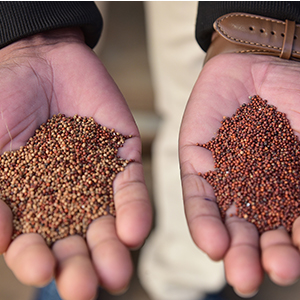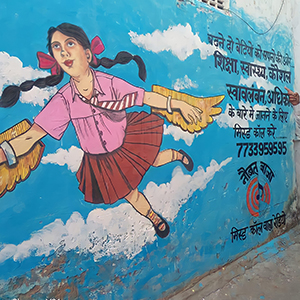
Over the past four decades, India has achieved rapid economic growth, gender parity in primary school enrolment, and a decline in fertility rates. Yet, according to the latest NITI Aayog report on India’s progress towards the Sustainable Development Goals (SDG), we are underperforming on SDG 5 – Gender Equality and Empowerment For All Women and Girls. Across Indian states, key gender equality outcomes such as labour force and political participation, wage parity across gender, gender-based violence reduction, and sex ratio at birth are persistently poor. This raises the question – which interventions can meaningfully increase gender equality outcomes?
Drawing women into the labour force can potentially address other gender inequities: female employment has been shown to delay marriage, increase female work aspirations, improve child health, and improve the skewed sex ratio. However, the gender disparity among working men and women in India has worsened in the last two decades, dropping significantly from 37% in 1990. Today 23.3 percent of women in India participate in the labour force, while men are three times more likely to be working. Aside from the economic benefit of improved female labour force participation (FLFP), women who work tend to have higher decision making power in their households.
Evidence from randomised evaluations suggests that FLFP can be enhanced by improving job market access for young women and providing them with financial control. However, researchers have also recognized the critical role that gender norms play in women’s lives. Therefore, this article highlights an effective and timely intervention to change the gender attitudes and behaviours of adolescents, at the age when values and gender attitudes are typically formed.

To identify what works to boost FLFP, researchers tested the effects of providing recruiting services for business processing outsourcing (BPO) jobs to young women (aged 15-21) in randomly selected rural villages. For three years, in villages located around Delhi, recruiters hosted half-day information sessions on BPO jobs. At the end of the intervention, girls who had access to these recruiting services were more likely to be employed outside the home and significantly less likely to have gotten married or had children, compared to peers who did not receive the sessions. The effects also led to better nutritional outcomes, as girls who received the sessions had a higher BMI than those who didn’t, suggesting that parents invested more in their nutrition and/or health.
Leveraging the formal financial system to ensure women have control over their potential wages may also be effective in promoting FLFP. In a study in Madhya Pradesh, researchers offered low-income women the opportunity to send their MGNREGS wages to an individual bank account (instead of an account owned by the household head), along with an information session that explained how to use a bank account. The direct MGNREGS deposit and training intervention led to increased employment both within the programme and in the private sector. This effect was potentially due women’s bargaining power increasing within the home as a result of increased financial control. Further, the gains in employment and earnings were largest among women who had previously been the least involved in the labour market, and whose husbands had initially expressed the most amount of opposition to females working, suggesting that more control over earnings increased women’s influence and agency.
However, increasing female entrepreneurs’ access to financial resources does not guarantee that this money will go towards women’s own enterprises. In an experiment conducted in Kolkata, researchers provided female micro-enterprise owners with either a standard loan, or an alternative contract with a two-month grace period before the first repayment was due, to understand the impact of eased financial constraints on women’s business profits. When the household had multiple (male and female) business owners, the grace period has no impact on profits of the female-operated enterprise. But when a female was the sole entrepreneur in her household, the grace period contract increased her business profits by roughly 75 percent, compared to female clients who received the standard contract. This suggests that despite being the formal recipient of the loan, female clients in households with multiple businesses redirected the loan to her husband’s business, potentially because their own business is lower return or because they lack effective control over this financial resource.
 Nearly a third of Indian women primarily engaged in housework would like to have a job, but restrictive norms may limit them from accessing opportunities in the job market. To understand if gender norms can be shifted at an early age through a direct intervention, researchers evaluated a school-based gender attitude change programme for adolescents in Haryana. Designed by the NGO Breakthrough, the programme consisted of interactive sessions that addressed gender stereotypes, gender roles and chores at home, girls’ education, women’s employment outside the home, and harassment. Owing to the programme, students expressed more gender progressive attitudes compared to those who did not receive the intervention. Moreover, the translation of attitude change into behaviour change was highly pronounced for adolescent boys, who enacted more gender-equitable behaviours such as doing household chores. The researchers will conduct follow-up studies to understand long term impacts such as educational attainment, occupational choice, marriage, and fertility for both female participants and the wives of male participants.
Nearly a third of Indian women primarily engaged in housework would like to have a job, but restrictive norms may limit them from accessing opportunities in the job market. To understand if gender norms can be shifted at an early age through a direct intervention, researchers evaluated a school-based gender attitude change programme for adolescents in Haryana. Designed by the NGO Breakthrough, the programme consisted of interactive sessions that addressed gender stereotypes, gender roles and chores at home, girls’ education, women’s employment outside the home, and harassment. Owing to the programme, students expressed more gender progressive attitudes compared to those who did not receive the intervention. Moreover, the translation of attitude change into behaviour change was highly pronounced for adolescent boys, who enacted more gender-equitable behaviours such as doing household chores. The researchers will conduct follow-up studies to understand long term impacts such as educational attainment, occupational choice, marriage, and fertility for both female participants and the wives of male participants.
There is tremendous scope for improvement of the gender equality outcomes enshrined in the SDGs, particularly around falling FLFP rates. Boosting women’s economic participation has long-term and inter-generational benefits for the individual, her family, and society. Policymakers and practitioners must test and scale interventions to improve women’s market access and increase her financial control. Further research must also explore the long-term impacts of changing young adolescents’ gender attitudes and behaviours. These evidence-based interventions to boost FLFP, such as empowering women with financial control, not just access, and shifting gender norms in adolescents are all promising ways to accelerate India’s progress towards SDG 5.
– Anna Rego, Policy Manager, J-PAL South Asia
Read more



